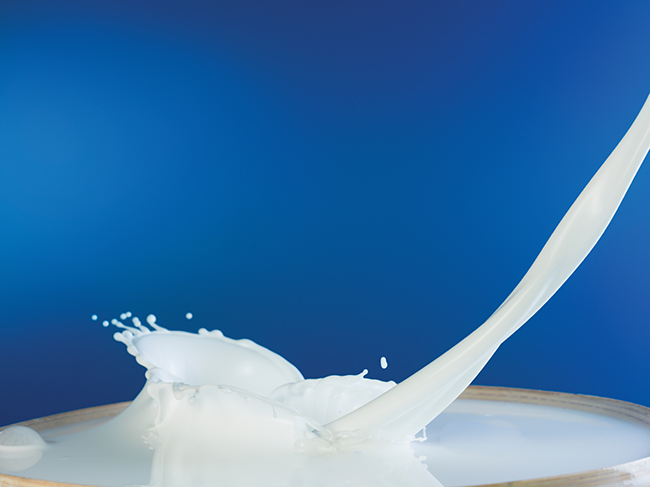While many of us may not be able to happily or safely digest lactose, this may not mean that we have to completely cut out dairy…

Lactose intolerance is one of the most common food intolerances, affecting up to 65% of the world’s adult population. Many people choose to completely cut out dairy as a way to avoid the gastrointestinal symptoms that frequently occur when eating dairy foods. But if you are lactose intolerant do you actually need to eliminate dairy completely? Nutritionist Christine Bailey looks at our options.
What is Lactose?
Lactose is the carbohydrate (or natural sugar) naturally found in all kinds of milk, including human milk. It can also be used as an ingredient in some food products.
What is lactose intolerance?
To digest lactose your body contains the enzyme lactase. Lactase splits the lactose into two smaller sugars, glucose and galactose in the small intestine. These smaller sugars are absorbed by your body to provide energy.
If you don’t have enough of the lactase enzyme to break down all of the lactose, the undigested lactose passes through the small intestine to the colon. In the colon, bacteria ferment the lactose and produce various acids and gas. This combination of events can lead to a number of symptoms including abdominal pain, bloating and diarrhoea.
Most people are born with the ability to produce the lactase enzyme because breast milk, like cow’s milk, contains lactose. Your chance of developing lactose intolerance later in life can be influenced by a number of factors including ancestry and racial background. As we age, the amount of lactase declines, but this also tends to be more common in people of Asian, African, South American, Southern European and Australian Aboriginal heritage than in people of Northern European descent.
You can develop lactose intolerance as a result of other health conditions such as gastrointestinal infections, coeliac disease and inflammatory bowel conditions. In some cases, this is temporary. Once the underlying health condition and inflammation has been addressed you may find you are able to tolerate some dairy again.

While medical testing is available, the majority of people self diagnose. This can lead people to mistake their gastrointestinal symptoms as a sign that they are unable to digest all dairy products. However, studies have shown that even diagnosed ‘lactose malabsorbers’ are capable of consuming moderate amounts of dairy, tolerating an average 12 grams of lactose when administered in a single dose (the lactose content found in 1 cup of milk) with little to no symptoms. Additionally, many people who believe they have lactose intolerance may in fact be suffering from other gastrointestinal disorders such as SIBO (small intestinal bacteria overgrowth), coeliac disease, or IBS, and do not see significant benefit from eliminating dairy.
Many dairy foods do not contain large amounts of lactose. For example, most cheeses contain virtually no lactose and are usually well tolerated. People often find they can tolerate yoghurt which may be because it contains bacteria that ferment the lactose helping to break it down. Butter is also virtually lactose-free.
Lactose content of dairy foods
You may be wondering why eating dairy even matters. Several studies have shown that individuals with lactose intolerance have lower bone density and are at higher risk for fractures and osteoporosis, likely due to their inadequate calcium intake. This risk may also be exacerbated by low K2 consumption; as certain dairy foods, particularly cheese, is one of the best sources of vitamin K2. While there are other sources of calcium, many people find it challenging to get enough from leafy greens, nuts or bone-in fish.
So if you do have lactose intolerance and have been avoiding dairy you may want to think again. There are many low lactose containing dairy foods that may be suitable. As everyone varies in the amount of lactose that can be tolerated it is recommended you try a little butter or hard cheese first, which are virtually lactose-free. You can of course switch to lactose-free dairy products (see below).
Here are some other tips to help you incorporate some dairy in your diet without the tummy pain.
- Switch to lactose-free dairy products – there is a good variety of lactose-free dairy products including milk, cheese, yoghurts and cream.
- Spread out your dairy consumption over the day rather than eating a large amount in one meal.
- Build up your tolerance. Start small and gradually increase your consumption of dairy foods.
- Full fat milk may be better tolerated than low fat or skim milk. Fat slows the passage of lactose through your digestive system giving you more time to digest it.
- Different brands of yoghurt will vary in the amount of lactose they contain. So experiment with different products. Making your own yoghurt and fermenting it for longer (12-24 hours) will reduce the lactose content further.
- Some studies have shown that supplementation with probiotics can alleviate symptoms of lactose intolerance by modifying the metabolic activity of our gut bacteria.
Of course if you have an allergy to dairy proteins, then lactose-free is not appropriate for you. Speak to your doctor if in doubt.
Lactose content of dairy foods
|
Milk – all types 1 cup / 250ml |
12-15g |
|
Cheddar cheese, 40g |
0.04g |
|
Parmesan cheese, 40g |
trace |
|
Ricotta cheese, low fat, 20g |
0.4g |
|
Yoghurt (natural), 245g |
5-9g |
|
Ice cream, 75g |
5g |
|
Butter, 1 tbsp |
trace |
|
Light cream, 2 tbsp |
1g |
|
Fat free dry milk powder, 20g |
12g |
|
Cottage cheese, 110g |
2-3g |
|
Condensed milk, whole, 2 tbsp |
4g |
|
Goat’s milk, 115ml |
9g |
|
Evaporated milk, 2 tbsp) |
3g |
